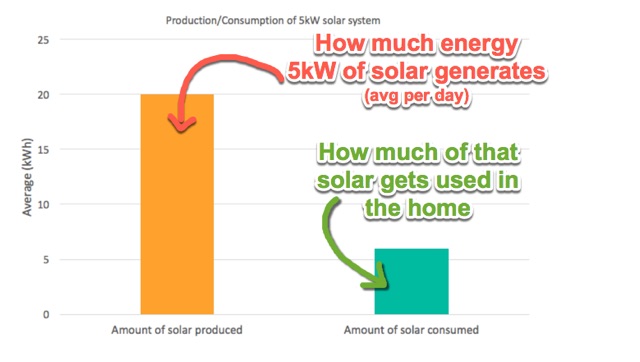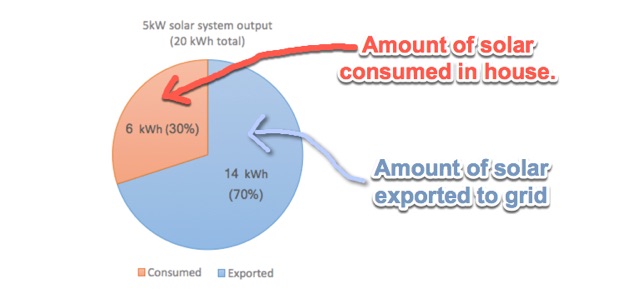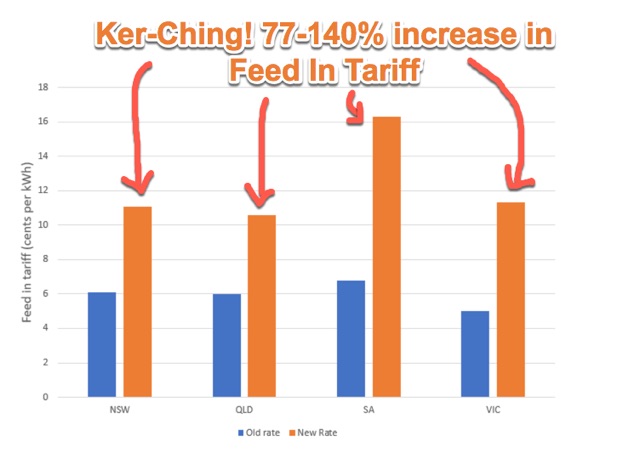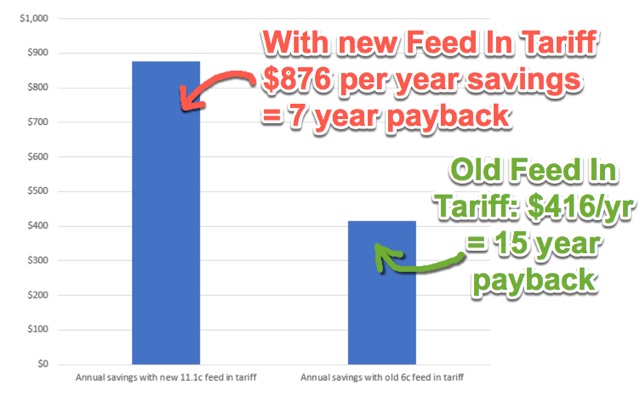Should you get solar if you’re not home during the daytime?
By Finn Peacock – Chartered Electrical Engineer, Ex-CSIRO, Founder of SolarQuotes.com.au
Since July 1st, 2017, if you live in South Australia, New South Wales, Victoria or Queensland, the answer has suddenly become “yes!” after being “no” for the last 5 years.
Before I explain the sudden change that has made solar power worth it for virtually everyone in the states above – let’s go back to basics.
Solar PV systems save you money in two ways – one major, and one minor.
Major savings
The main way a solar power system saves you money is by offsetting your daytime consumption.
Electricity costs, on average, 30 cents per kWh if you buy it from the grid. If your solar system generates a kWh at the same time your house needs a kWh – then you’ve just saved 30 cents by using (or ‘self-consuming’) your solar energy.
A 5kW solar system, which is the average size installed on a home in 2017, will produce 20kWh per day, on average.
The typical Aussie home would use enough energy during daylight hours to self-consume about 30-40% of that 20 kWh

Which works out to $1.80 worth of savings per day. This alone adds up quickly – but your total savings will be even bigger…
Minor savings
(Savings before July feed in tariff increase)
So if you consume 6kWh out of the 20kWh produced by a 5kW system, what happens to the remaining 14kWh?
The remaining 14kWh is fed back into the electricity grid, and you are paid a “feed-in tariff” by your electricity retailer. The amount you are paid per kWh varies from retailer to retailer, and also from state to state, but up until July of this year it was typically 6c per kWh.
So, before July of this year, that remaining 14kWh would be worth 84 cents per day – less than half of your savings from self consuming the solar. Ouch!
This is why it’s common to hear “I’d love to go solar, but most of my electricity usage is at night, so my solar system would just be feeding all of that electricity to the grid for a pittance!”
And to be clear – with crappy feed-in tariffs of around 6c per kWh, you’d be absolutely right to be wary of spending money on a solar power system if you’re not home during the day.
The July 2017 game-changer
The economic argument for solar panels over the past 5 years was pretty straightforward – if you can use at least 30% of your daily solar electricity generation, then it’s a no-brainer. If you’re not home during the day, solar power probably isn’t worth it, due to the low feed in tariff.
But a one-two punch delivered on July 1 has shaken that argument to its core.
2) Everywhere except WA and the NT will see their feed-in tariffs significantly rise
The reason for #2 is directly related to #1. The price you are paid for solar electricity fed into the grid is meant to directly reflect the wholesale price of energy.
If energy prices rise – feed-in tariffs are meant to rise in lock-step.
The table below shows the solar feed in tariff increases offered by AGL (different retailers offer different rates):
| State | Old rate (c/kWh) |
New rate (c/kWh) |
Increase |
| NSW | 6.1 | 11.1 | 82% |
| Queensland | 6.0 | 10.6 | 77% |
| South Australia | 6.8 | 16.3 | 140% |
| Victoria | 5.0 | 11.3 | 126% |
Suddenly, solar power is worth it even if you’re not home during the day.
Let’s do some simple maths to show why this makes solar panels an absolute no-brainer for even the most pessimistic of self-consumption scenarios, using New South Wales as an example.
With the July increase in power prices and feed-in tariffs, using AGL’s rates as an example, you’ll now be paid 11.1c per kWh exported to the grid (up from a crappy 6c per kWh!).
Virtually every modern Australian home will use some amount of energy during the daytime, due to fridges or other appliances that run on standby.
Let’s assume that a home with a 5kW solar system self-consumes a mere 5% of its generated solar energy. This amounts to a saving of around 30c per day.
So the remaining 19kWh of electricity would be sent back into the grid, and you would be paid 11.1c per kWh, totalling $2.10 worth of savings per day. Add in the 30c saving from the 1kWh that you self consumed, and that system would save you $2.40 per day
Extrapolated over an entire year, that 5kW system would save you, at an absolute minimum, $876 per year off your electricity bills.
So, what do solar panels cost? Today you can get a really great quality 5kW solar system, which will last about 25 years, for around $6,500. So $876 worth of savings per year equals a payback time of just over 7 years – leaving an extra 18 years of savings once the system has been paid off.
(To compare this with the annual savings with the old 6c feed in tariff with 95% export, you’d be looking at $416 – stretching your payback to 15 years!)
And keep in mind the above example is a worst-case self consumption scenario. A much more typical self-consumption rate of around 30% will see paybacks of around 4 years.
So is solar right for you, even if you’re not home during the day? Since July 2017 – it probably is!
If you’ve had a gutful of electricity price hikes and would like to harness the power of the sun to help control your energy costs, you can get solar quotes from three pre-vetted installers by clicking the button below:
“Many thanks…
I was a lost sheep in a field of wolves without your help”



